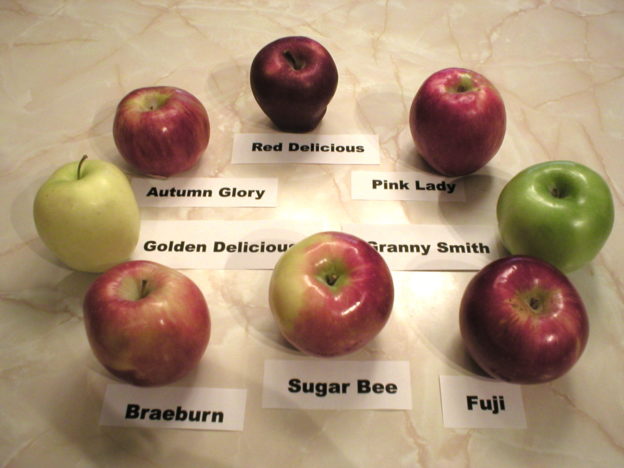Apples 101 – About Fuji Apples
Origin
Fuji apples originated in Fujisaki, Japan in the late 1930s. Growers at the Tohoku Research Station cross pollinated Red Delicious and Virginia Ralls Janet apples to create the Fuji. Since the apple was introduced in the United States in the 1980s, its popularity has grown to becoming one of the most sold varieties of apples. Today, the United States grows more Fuji apples than Japan. Their popularity has grown to becoming the most commonly grown apple around the world.
Nutrition and Health Benefits
Fuji apples are an excellent source of Vitamin C. They are also a good source of fiber along with some Vitamin A, iron, potassium, folate, magnesium, manganese, calcium, riboflavin, Vitamin B6, Vitamin B1, and pantothenic acid. One medium Fuji apple has about 100 calories.
Vitamin C is a critical antioxidant in the body and benefits health in a number of ways. Not only does it help to boost the immune system and support skin and membrane health, but Vitamin C also plays a role in preventing diabetes, cancer, and other medical conditions such as gout, high blood pressure, and iron deficiency.
One Fuji apple supplies between 4 and 5 grams of fiber, most of which is in the skin. Adequate fiber in the diet not only keeps the contents of the intestines moving forward, but it helps to lower blood cholesterol and reduce the risk of developing heart disease, cancer, and diabetes.
The peel of Fuji apples not only contains fiber, but also quercetin, a flavonoid that has been found to reduce the risk of heart attack by about 32 percent. In fact, Fuji apples have been found to have the highest overall concentration of bioflavonoids of any variety of apple. Quercetin and other bioflavonoids help protect us from serious diseases such as heart disease and cancer. They also help to maintain our overall health including controlling weight. Researchers have found that regular consumption of apples, like Fuji apples, may reduce our risk of lung cancer significantly, by up to 50 percent.
Characteristics of Fuji Apples
Appearance. Fuji apples are moderate in size and are somewhat round with a slight lopsided appearance. They have a semi-thick skin that is smooth, waxy, and has a yellow-green base covered in red-pink striping and blush. The skin colorations may vary depending on cultivation techniques. The flesh is dense, juicy, crispy, fine-grained and pale ivory to white in color.
Flavor and Texture. Fuji apples are dense, juicy, and crisp, with creamy white flesh. The apples are well-known for their exceptional sweetness, low acidity, juiciness, firmness, and crispiness. Their blend of sweetness and acid gives them the perfect balance of a sweet-tart flavor. Some people consider them to be the sweetest of all apple varieties. They have a Brix (sugar) level of 15 to 18, making them to be among the sweetest of apples.
Storage/Shelf-Life. Fuji apples have a long storage life, making them available year-round. When kept in a cool, dry, and dark place, such as a refrigerator, Fuji apples can keep for 3 months. Fuji apples are one of the best apples for freezing.
Best Uses for Fuji Apples
Fresh. Fuji apples are wonderful when eaten fresh. They are refreshing and satisfying. They can be sliced and tossed into green and fruit salads, grated into coleslaw, or chopped and used as a topping over oatmeal, pancakes, and cereal. They can be sliced thin and added to sandwiches. They may even be placed on a stick and dipped in caramel or candy coatings for a sweet treat at food festivals. Fuji apples pair well with assorted cheeses such as cheddar, goat, brie, Gorgonzola, and blue cheeses. Fuji apples can also be pressed into juices, and made into apple cider and wine.
Baking. Fuji apples are excellent when baked into pies, cakes, tarts, quiches, crumbles, crisps, and muffins. They can even be used as a pizza topping. They hold their shape well when baked, so they would be an excellent choice for baked apples.
Cooking. The thick skin and dense flesh of Fuji apples allows them to hold up well when cooked, making them a popular variety to be used in soups and roasts. Fuji apples pair well with meats such as pork chops, bacon, sausage, turkey and poultry. They can also be mashed into potatoes. They pair well with vegetables such as spinach, cabbage, Brussels sprouts, and green beans. Fuji apples can even be chopped and added to rice dishes for a touch of sweetness.
Drying. Fuji apples hold up well when dehydrated. As with any other apple, they should be first treated with an acid solution (such as lemon water) to prevent them from turning brown during the process.
Recipe Links
Ultimate Apple Crisp https://dinnerthendessert.com/classic-apple-crisp-double-the-crisp/
Fuji Applesauce https://www.simplyrecipes.com/recipes/applesauce/
Japanese Apple Salad https://www.justonecookbook.com/apple-salad/#wprm-recipe-container-60329
Apple Cinnamon Oatmeal Stovetop Recipe https://www.sugardishme.com/apple-cinnamon-stovetop-oatmeal/
Waldorf Salad https://appleforthat.stemilt.com/recipes/waldorf-salad/
Easy Apple Crisp https://www.bowlofdelicious.com/apple-crisp/#recipe
Slow Cooker Baked Apple Dessert https://www.yummly.com/recipe/Slow-Cooker-Baked-Apple-Dessert-1216726
Maple Pecan Apple Crisp https://www.yummly.com/recipe/Maple-Pecan-Apple-Crisp-1914147
Apple Almond Galette https://www.yummly.com/recipe/Apple-Almond-Galette-1793662
Hungry Girl’s Slow Cooker Apple and Oat Goodness https://www.yummly.com/recipe/Hungry-Girl_s-Slow-Cooker-Apple-_-Oat-Goodness-2061874
Easy Oven Baked Fuji Apple Chips https://www.onsuttonplace.com/oven-baked-fuji-apple-chips/
Baked Fuji Apple Slices https://healthyrecipesblogs.com/baked-apple-slices-recipe/#recipe
Healthy Baked Apples https://thecleaneatingcouple.com/healthy-baked-apples/#recipe
Dehydrated Cinnamon Apples Recipe https://recipesworthrepeating.com/dehydrating-apples-cinnamon-apples-recipe/
Resources
https://www.stemilt.com/fruits/apples/fuji-apples/
https://www.specialtyproduce.com/produce/Fuji_Apples_914.php
https://bestapples.com/varieties-information/varieties/#
http://www.milesfarmersmarket.com/wp-content/uploads/Produce-Apple-Chart-Uses.pdf
https://www.openfit.com/a-guide-to-the-most-popular-apple-varieties
https://www.tasteatlas.com/most-popular-apples-in-the-world
https://www.taste.com.au/quick-easy/articles/ten-secrets-of-fuji-apples/50penv88
https://recipesworthrepeating.com/dehydrating-apples-cinnamon-apples-recipe/#ingredients-youll-need
https://appleforthat.stemilt.com/theres-an-apple-for/dehydrating/
https://tools.myfooddata.com/nutrition-facts/167793/wt3
https://www.livestrong.com/article/375943-fuji-apple-health-benefits/
https://www.webmd.com/vitamins/ai/ingredientmono-294/quercetin
https://www.healthline.com/nutrition/vitamin-c-benefits#5.-Helps-prevent-iron-deficiency
About Judi
Julia W. Klee (Judi) began her journey enjoying “all things food” in elementary school when she started preparing meals for her family. That love of food blossomed into a quest to learn more and more about health and wellness as related to nutrition. She went on to earn a BS Degree in Food and Nutrition, then an MS Degree in Nutrition. She has taught nutrition and related courses at the college level to pre-nursing and exercise science students. Her hunger to learn didn’t stop upon graduation from college. She continues to research on a regular basis about nutrition as it relates to health. Her hope is to help as many people as possible to enjoy foods that promote health and wellness.

